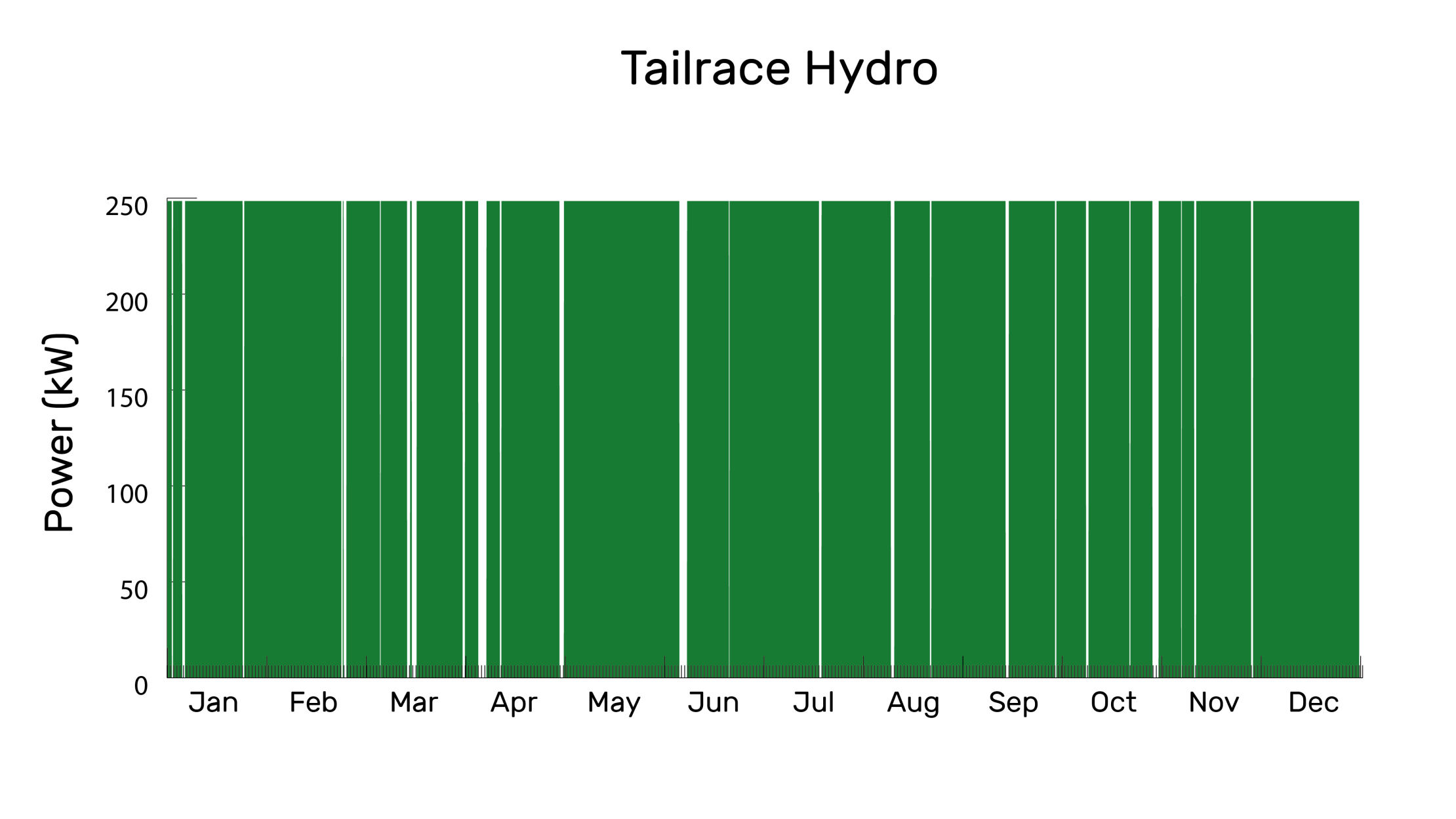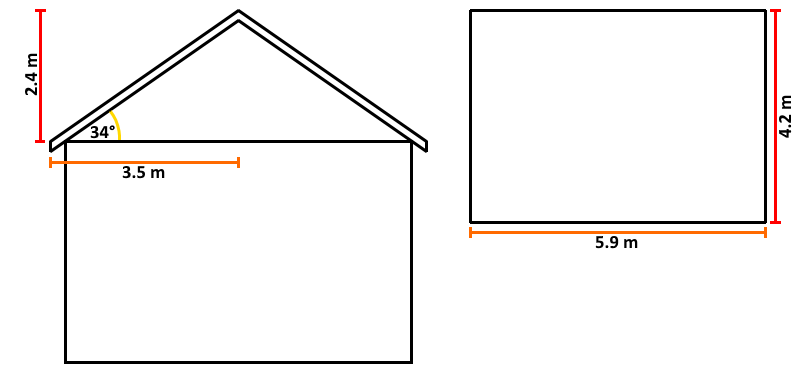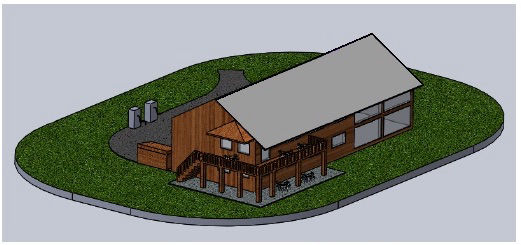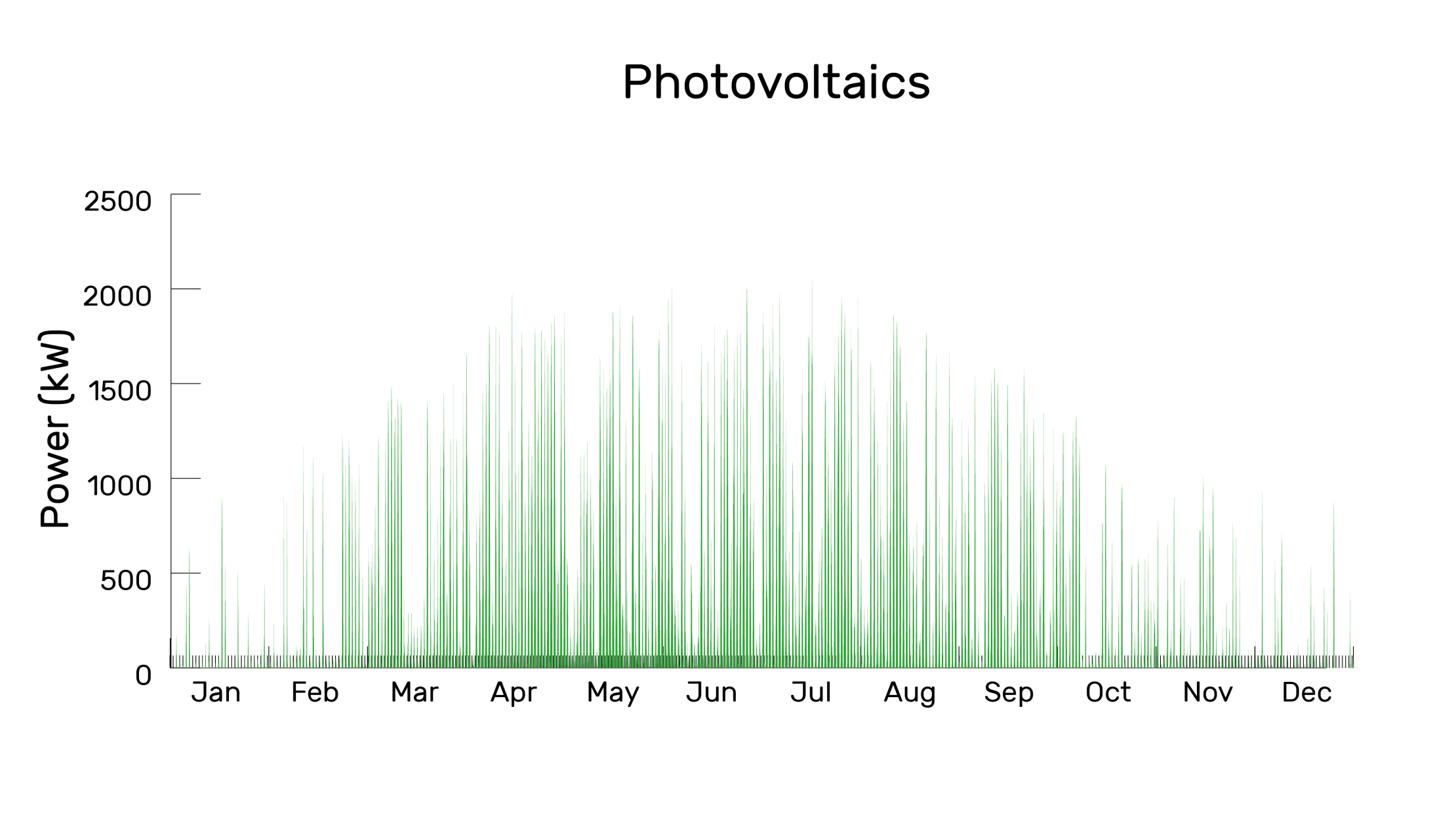Two community owned renewable energy generation systems have been proposed.
Kinlochleven is host to a hydro power scheme owned by the SIMEC Group. The hydro scheme had a capacity of 19.5 MW as of November 2018, with plans to increase its capacity to 27.5 MW by the end of 2019 [18]. The water exits the hydro plant through a tailrace channel which stretches from the hydro scheme to the River Leven. The water gains velocity along the channel, with a surface velocity of 4.5 ms-1 before the channel widens 10 metres from the end. The outflow water is then ejected from the channel into the River Leven, falling through a height of approximately 2 metres. By considering the information supplied by the turbine manufacturer, at a capacity of 27.5 MW, the flow rate of water through the channel calculated to be 11.4 m3s-1 [19].
The kinetic and gravitational potential energy of the outflow as it reaches the end of the tailrace present possible opportunities for electricity generation.
The location of the tailrace and the SIMEC power station are highlighted in the map below.
There are two main categories of turbine types used in hydro generation, impulse turbines and reaction turbines. Impulse turbines operate by extracting purely kinetic energy from the flow, whereas reaction turbines utilise a pressure change across them. For the tailrace in Kinlochleven, both types of turbine were considered. Based on the dimensions and characteristics of the tailrace, impulse turbines were considered suitable for location in the tailrace channel, while reaction turbines were considered suitable to make use of the head difference from the end of the tailrace to the river. A summary of the various turbines considered to be viable are shown in the table below.
| Turbine Type | Suitable Flow Rates (m3s-1) | Suitable Head Range | Efficiency | Additional Considerations |
|---|---|---|---|---|
| Undershot Waterwheel | 0.5 - 1 per m width [20] | Up to 2.5 m [20] | Up to 30% [21] | • Impulse turbine
• Low capital cost |
| Poncelet Waterwheel | 0.5 - 1 per m width [20] | Up to 2.5 m [20] | Up to 50% [21] | • Impulse turbine
• Low capital cost |
| Archimedes' Screw | 0.05 - 20 | 0.8 - 8 | 70% [22] | • For high flow rates, the diameter of the screw may be too large for the tailrace geometry. |
| Propeller Turbine | 4 - 60 | 2 - 12 | Up to 90% [23] | • Reaction turbine
• Efficiency varies significantly with flow rate. |
| Kaplan Turbine | 4 - 60 | 2 - 12 | Up to 90% [23] | • Reaction turbine
• Efficiency is maintained over a wide range of flow rate. |
$$P{_{KE}} = {{1\over2}\rho \dot{Q}v^2}$$
$$P{_{PE}} = {\rho g \dot{Q}\Delta h}$$
To determine a feasible electrical power output from a hydro scheme in the tailrace, the hydraulic efficiency of the proposed turbine was applied to the power available in the flow. A conversion efficiency was then applied to account for conversion losses that occur in gearboxes, electric generators and inverters. Based on the reviewed literature, the following efficiencies were used in the calculations [25]:
ηKaplan Turbine = 90%
ηConversion = 90%
The quantity of energy that the tailrace hydro scheme could generate over a year was estimated by applying a capacity coefficient to the energy that the scheme would generate if it was to run consistently at full capacity. Based on statistics provided by the Renewable Energy Foundation, the Kinlochleven Power Station averaged at a yearly capacity factor of 94% between 2002 and 2018, which is exceptionally high even for hydro schemes [26]. The flow of water through the tailrace is therefore mostly at peak volume. To determine the possible energy generation by the tailrace scheme, the capacity factor of the hydro plant was used. To achieve this, all maintenance to be performed on the tailrace hydro plant would be required to coincide with the downtime of the main hydro plant above.
| Available Power in Flow (kW) | Net Power Output (kW) | Yearly Energy Output (GWh) |
|---|---|---|
| 307 | 248 | 2.05 |

Despite being in the Scottish Highlands, Kinlochleven has feasible potential to generate renewable energy through PV technology. Kinlochleven has many potential locations for implementing PV panels. As part of the residential dwelling retrofit, PV panels should be installed in line with newly upgraded roofs. The local high school has a south facing roof which would provide an ideal area for a large PV array.
The generation potential of PV is highly seasonal and weather dependent. For modelling purposes hourly weather data from a site just outside Glasgow was used (55.50 N, -4.15 W). This data has been altered to account for the geographical location of Kinlochleven (56.71 N, -4.96 W). This data is available from the download page.
The modelling considered two different types of PV panels for the locations identified:

The semi-detached model used for retrofit modelling was reused to model various sized PV systems. One half of the roof was used (~25 m2) to model a 4 kW system for the two types of panel to find the optimal configuration. The pitch angle was extracted from the ESP-r model and was kept consistent at 34 degrees, a diagram for the roof geometry can be found above. An array consisting of 16 X 250 W panels yielded the best results as it generated more energy for the roof area available.
The modelling of the semi-detached PV system was extrapolated to cover all dwellings with roof space in the village. Scaling for larger roofs and excluding low story flats resulted an equivalent of 426 of the 4 kW arrays. The housing roof directions where summarised from Google Maps and the suitable roof orientations.
The following table shows the proportion of usable roof orientations within the village and potential generation.
| Roof Orientation | Proportion of Roofs | Generation per Array (kWh/year) |
|---|---|---|
| East | 15% | 3000 |
| South East | 40% | 3460 |
| South | 15% | 3700 |
| South West | 15% | 3560 |
| West | 15% | 3150 |
The resultant generation from residential PV was calculated to be 1.45 GWh/year for the village.
The location of the residential dwellings, where it is proposed that PV panels be installed, can be found on the map below.
Kinlochleven's high school is located with the Leven Centre which has several different purposes. It has the largest solitary roof within the village with an area of 1070 m2, which is conveniently south facing. Utilising this roof area, a 200 kW system consisting of 400 of the 500 W panels was modelled with a 34° roof pitch.
This resulted in a generation of 0.15 GWh/year.
The location of the school can be found on the map below.

